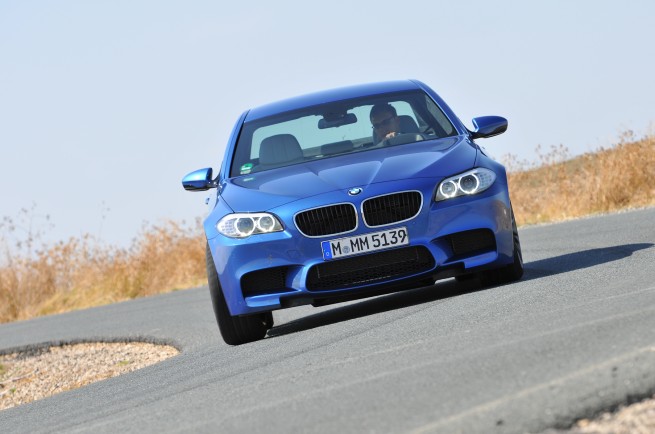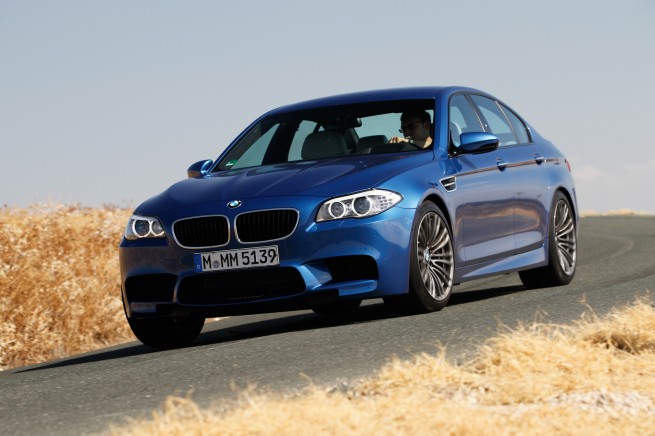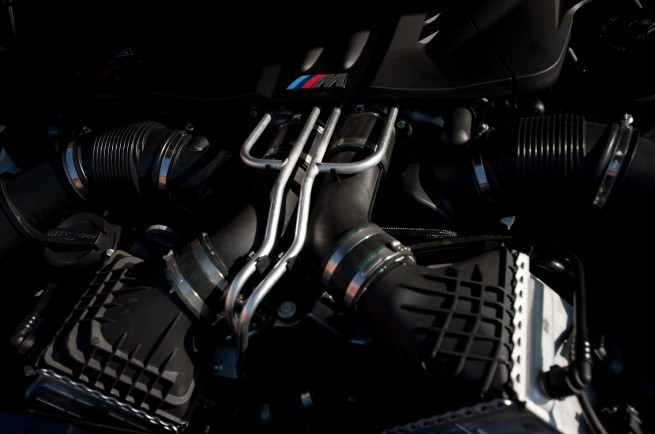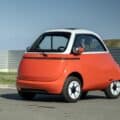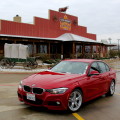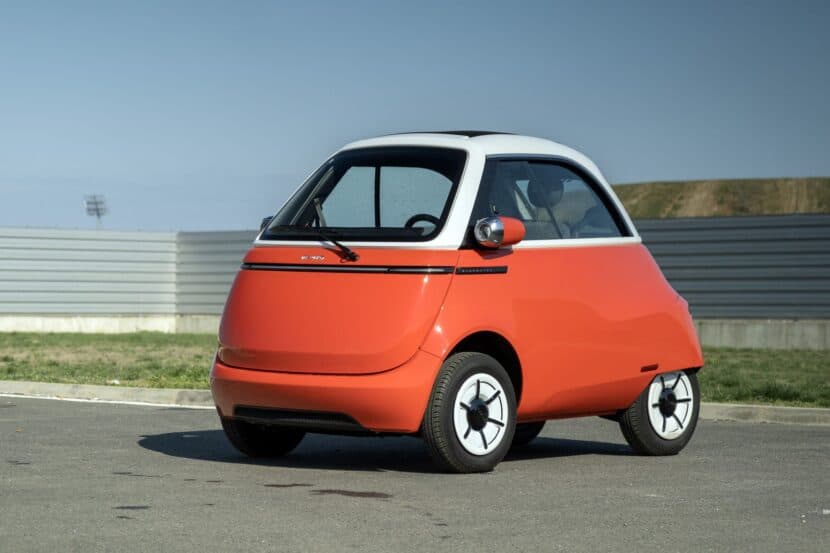Laying quietly under a thin sheet of aluminum is BMW M’s latest technological marvel. Known internally as the S63tu (technical update), this latest M engine is an advancement over the previously employed S63 V8 in the X5/M and X6/M “Super-utes.” The basic layout and structure is the same, with both the S63, and S63tu sharing the same block, head, and the majority of components. Both engines are Twin Turbo, Twin Scroll 90′ V8 units featuring BMW’s patented cross-bank exhaust headers, continuously variable valve timing on both the intake and exhaust side, and high precision direct fuel injection.
However, a divergence occurs due to the new M5’s higher compression ratio of 1:10. In fact, BMW M have made so many changes to the original S63 V8 found in the X/M cars that they have labeled it a “newly developed” engine. To create the higher compression ratio BMW have fitted newly shaped pistons. Boost pressure has been dropped by 0.1 Bar, but larger intercoolers have been added. The turbo chargers themselves are also new, feature a larger turbine diameter. A new valvetrain has been added wherein BMW has used Valvetronic variable valve lift throttle the intake, and throttle bodies exist in the engine, but they are in hibernation, used only in “limp home” mode. BMW has also completely revamped the electronic engine management in nearly every parameter, resulting in several improvements including a higher redline, now found at 7,200 rpm.
You’re probably wondering: with all of these changes, how come the new M5 only gained 5 horsepower over the X/M cars? The short answer is, BMW have chosen to focus on efficiency and drivability (read: throttle response) over all-out horsepower. Is the M division capable of squeezing more power out of the new M5 engine? Undoubtably. But as history testifies, massive horsepower has never been what M cars are truly about.
So how does efficiency compare to the previous generation E60 M5? The new F10 M5 drinks 30% less fuel – a staggering figure no doubt – while producing 10 percent more power and 30 percent more torque. This increase in efficiency will be greatly appreciated by all – even those who believe global warming is a scam – because as consumption is reduced, range in increased, which means fewer stops at the petrol station, or potentially no stops on your lengthy road trip (especially considering the massive 80 Liter fuel tank). On the EU test cycle the new M5 managed 9.9 Liters/100 Km (28.5 mpg). Those who aren’t stuck on the couch watching conspiracy theory movies will also appreciate the reduced emissions, now down to a very un-supercar-like 232 g/km in the EU5 test cycle.
One of the defining features of the M5’s M engine is its compact layout, placing both turbos and catalytic converters inside the ‘V’ of the 90′ cylinder banks. Like too many people on the dance floor, things get pretty cramped and hot in this small space. Engine cooling is therefore of paramount importance, and an extremely powerful cooling system including large intercoolers have been used to meet this demand. The front end aerodynamics have also been sculpted to guide sufficient airflow into the radiators and around the engine and brakes.
Besides its compact design, the placement of the turbos within the ‘V’ of the cylinder banks has one particular benefit: throttle response. As you decrease the distance from the exhaust valves to the turbine blades of the turbo, you decrease the amount of time it takes for the exhaust gases to reach, and spin the turbine – which in turn increases intake boost. Typical turbo charged engines suffer from ‘turbo lag’ – the time delay between stepping on the throttle (the exhaust pressures building, the turbos spooling, intake pressures building) and feeling acceleration. In short, BMW M’s design solution almost completely eliminates perceptible lag. It’s that good. (For a more in-depth consideration of turbocharging and the technology behind it, hit the jump to our previous tech feature.)
Also reducing turbo lag is BMW’s patented cross-bank exhaust manifold. Each cylinder bank of four cylinders donates exhaust gases from one of its cylinders to one scroll of one turbo. Therefore, both scrolls of both turbos have two dedicated cylinders feeding them at all times – but the pairing of these cylinders is where we find the magic. Based on the firing order of the V8 across both banks of cylinders, an exhaust pulse is evenly distributed to both scrolls of both turbos, keeping them spooled at all times, and across the entire RPM range. It sounds impressive on paper, but in practice – it is staggering. Oh, and the sound! The unique routing of each cylinder through the manifold results in a very characteristic sound, something different and exotic to your ears. It only lends further credence to the labeling of the M5 as a consummate supercar.
The new M5 has so little throttle lag that you might as well say it has none, in the sphere of turbo-charged cars. Although physics suggests it is impossible to entirely remove lag from a turbocharged engine, your senses from behind the wheel will struggle to find any. Only in higher gears will you find a small disconnect between the gas pedal and the rear wheels. After driving the M5 I can say with authority that the new turbo V8 is nearly “lag free” in my books – and that’s a big statement. Throttle response is direct and precise enough to throttle steer and drift through rather tight roadways – and there could be no greater praise heaped upon the turbo V8. Car control is everything – especially in an M car.
I have spent a considerable amount of time punching in laps with BMW’s X6/M, and I’ve always been impressed with its near instantaneous throttle response. But the M5’s mill is better – it closes the gap to perfection. Whereas in the X6/M you still wait for the power to build, in the M5 it’s just there. It’s always there. Ready to thrill you, ready to break the rear tires loose in a tail-out power slide, ready to stretch your cheeks back and widen your eyeballs.
BMW’s previous M5, the E60 M5 was an impressive car in every way. It’s engine was phenomenally good – revving to a stratospheric 8,250 rpm. The V10 blazed its way to maximum power output of 507 hp. But a key difference is found between the maniac V10 and the bludgeoner turbo V8: drivability. You see, the V10 managed 384 hp at 6,100 rpm, and it wasn’t until you hit 4000 + rpm that you began to feel a power surge. But the new M5’s V8 is different. It develops 100% – read it: one-hundred-percent of its torque at 1,500 rpm. This is axe-murderer appeal, the kind of brute twist that is borderline violent. There’s more… the torque output remains at 100% all the way until 5,750 rpm where it begins to drop off towards redline – but still not falling far below 400 lb ft at redline! What a machine. In fact, this engine produces 405 lb ft of torque a hair above its 1000 rpm idle. Parking valet boys: be forewarned.
So while it is true that the new M5 does not rev as high as its predecessor by approximately 1000 revs, it is also true that its powerband is approximately three times as wide – and that speaks volumes. As the saying goes, “horsepower sells cars, torque wins races.”
Maximum horsepower also finds a plateau to rest on between 6,000 rpm and 7,000 rpm. A full-bodied 560 horsepower leaves the crankshaft, dropping off slightly from 7,000 rpm to its 7,200 rpm redline. This drop off in power is seen on dynographs, but I assure you, it is not felt from the seat.
The new turbo V8 really is a marvel of engineering; a technological masterpiece better appreciated on the racetrack than on paper. On that note, stay tuned for our racetrack review of the new M5, to be published shortly. A full BMWBLOG First Drive review is soon to follow.
(Photos Credit: Daniel Kraus, Shawn Molnar)
